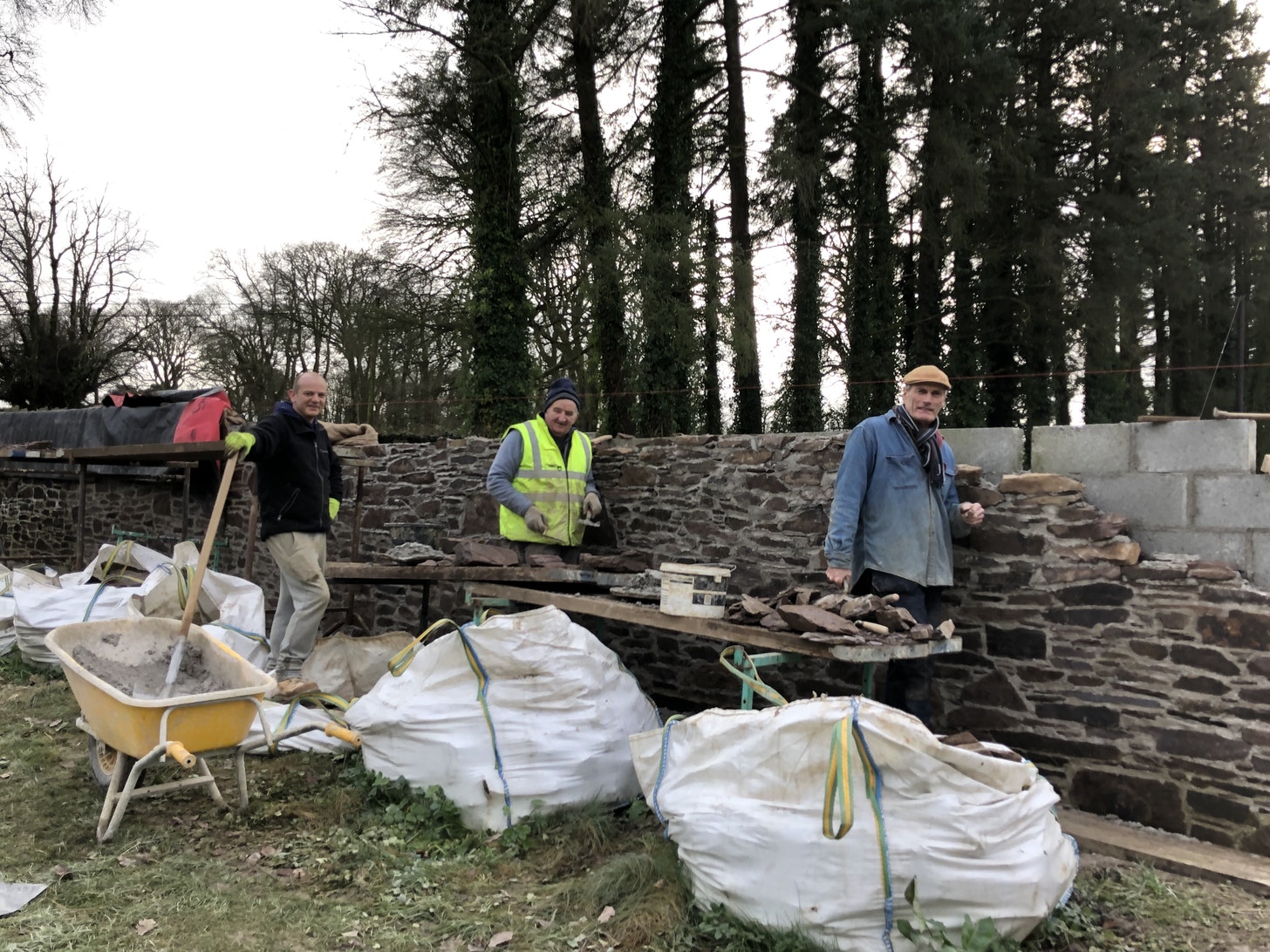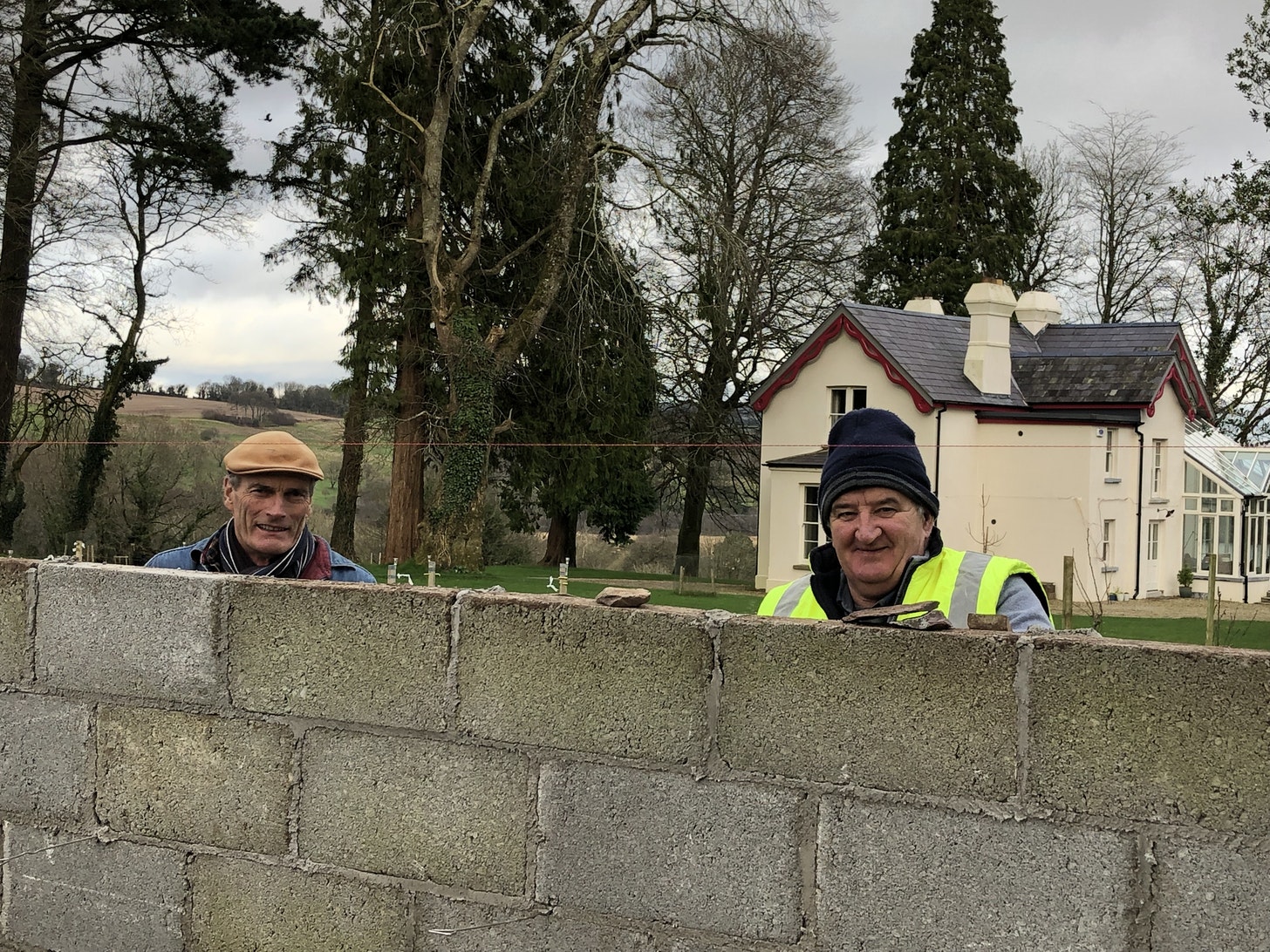We’ve come up to Dublin for a few days to help take care of a grandchild.
Before leaving home, we decided to spend a couple of days working alongside Mick and Connie, the local stonemasons. They were building a wall on the side of our garden until Mick came down with COVID. Then, the project stalled for almost a year. Here, we’re helping them to pick it up again:
|
|
| Source: Your editor — right — contemplates the next stone |
|
|
| Source: Securing the perimeter |
We’ve done masonry work for 50 years…but very little stone masonry. Mick is a real old-time pro. We thought we might learn something from him.
‘It’s not the stone you’re laying that you need to worry about,’ he said. ‘It’s the next one that gives you trouble.’
Thus had Mick brought into focus the problem of all human life. Actions have consequences. Today is followed by tomorrow…which is when the troubles arrive.
Mick was merely pointing out that a poorly-laid stone makes it difficult to pose the next one on top of it. But the principle is universal: problems always reveal themselves later.
It may be fun, for example, to have a fling with the hat-check girl. But then what?
Rob a liquor store? Same problem.
Try to goose up the US economy with artificially low interest rates (below zero in real terms) and printing press money? Yeah…there will be Hell to pay.
The cost of doing business
But we are going to desist from our usual old-school, middle-American moralising…
…instead, we take up a practical Dear Reader’s question.
Our reader has noticed that we own a lot of non-performing real estate. He guesses, correctly, that they must cost us money:
‘From following you all these years, I know that you own many properties around the world including several hundred thousand acres of land. Having been involved in the real estate business for 40 years, I know that without substantial rental income these properties become a drain. So my question is, does someone in your position think about the effects of negative cash flow or does it continue to be the cost of doing business?’
Our reader puts it politely, but the gist of his question is: what kind of fool are you; what about the consequences?
Herewith…an explanation.
And we begin by taking the high road: not everything we do is intended to make money.
We have farms in France, the US, Nicaragua, and Argentina. None were bought as serious farm investments (although…we had hopes!). We lose money on all of them.
Is this a good idea? Probably not. Each one makes us poorer. But heck…we have no other expensive tastes or hobbies. No fast cars. No corporate jet. No art collections. No racy girlfriends. No yachts. We rarely travel for fun (besides, it’s not much fun anymore). Our houses are modest. We drive a Ford F-150. We wear Lee blue jeans.
If we have a weakness, it’s property. We like owning it. We like fixing old houses and restoring old fields, fences, and gardens. And we tell ourselves: after all our improvements, maybe…when we finally shake the clods off our boots…perhaps the grandchildren will be able to sell them at a profit.
Or maybe not.
And since, as our reader points out, these properties produce ‘negative cash flow’ we have to be careful. Annual negativity could overwhelm the eventual positivity, such as it may be.
How to Survive Australia’s Biggest Recession in 90 Years. Download your free report and learn more.
Contrarian farmers
We’re also getting older. In the final innings of our career, we’re learning how to bunt and walk — how to cut costs…increase income…and invest in better land. And overall, we’re almost at breakeven!
Yes, while we own a lot of ‘non-performing’ farmland, we are also buying performing farmland. And here is where our globetrotting gives us at least a broader perspective. We’ve become ‘contrarian farmers’. No…we don’t plant backwards to fool the crows. Instead, we are buying land in Argentina.
Here in Ireland, we were bidding on an adjoining farm. The bids went up and up…until the price was more than US$12,000 an acre. We gave up, figuring that the local bidder wanted it more than we did. At that price, it’s hard to see how it could ever be profitable. But like us, the Irish like owning land. Perhaps it brings a psychic benefit that doesn’t appear on an income statement.
Meanwhile, in Poitou, France, land sells for only about US$5,000 a hectare…or about US$2,000 an acre. It was always poor land. Still is. And the rental income is running about US$50 per acre/year — a rate of return of about 2.5%…not enough to cover the taxes and maintenance.
In the US, in the Upper Midwest, rental rates are running about US$225 per acre. Iowa farmland is trading hands at about US$7,000 an acre. So the return on investment is only a bit better than in France.
Crop yields are heavy in the US. And prices are high. Farmers should be doing well. Trouble is that costs are rising sharply too. Potash, nitrogen, and phosphates approximately doubled last year. Costs for fuel, pesticides, herbicides, and seeds are also going up. Farming is no clear winner in an era of rising inflation.
Meanwhile, down in the northwest corner of Argentina, there may be a unique opportunity. A terrible drought has wreaked havoc. And whatever damage nature leaves undone, the Argentine government fills the gaps. Effectively, farmers cannot sell their land to foreigners — substantially lowering market demand. And even if they could buy, non-Argentines would find that they couldn’t repatriate their profits except at the ‘official rate’…which would wipe out at least half the value of their earnings. The peso is getting cut in half each year. Shortages of machinery, fuel, and chemical products bedevil the hard-pressed gaucho farmers.
There is not yet any light visible at the end of this tunnel. And it’s rather amazing that there’s any market at all for Argentina farmland. But there is. And prime cereal land — good for wheat, soy, corn, or other field crops — sells (up in Salta province) at about US$1,200 per acre, an 80% discount from US prices.
Crop yields are lower than in the US. But so is the dependence on fertilisers and pesticides.
This leaves, we believe, the Argentines in a strong position among the world’s low-cost producers. And in recent years, returns to investors have been running between 5% and 10% (not counting farmland capital appreciation).
In any case, our goal is modest. We only seek to make enough to cover the losses on our other Argentine farming ventures. Then, we can leave the farms to our children with a clear conscience; at least, they won’t be a burden.
We’ll be heading back down to the pampas in March…to have a closer look — stay tuned for an update.
Regards,
 |
Bill Bonner,
For The Daily Reckoning Australia
PS: None of this should be taken as investment advice, by the way. Land is not fungible. Each situation is unique. Each requires management…and careful, detailed knowledge of the facts on the ground.



